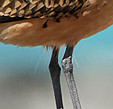tags: Bristle-thighed Curlew, Numenius tahitiensis, birds, mystery bird, bird ID quiz
[Mystery bird] Bristle-thighed Curlew, Numenius tahitiensis, photographed on Midway Atoll National Wildlife Refuge -- one of the most remote coral atolls on earth -- a US territory in the north Pacific Ocean [I will identify this bird for you in 48 hours]
Image: Joe Fuhrman, 2010. I encourage you to purchase images from this professional photographer. [larger view] I encourage you to purchase images from this professional photographer.
NOTE: Please name at least one field mark that supports your identification.
 For those who can't see this bird's bristles, they're actually quite visible, as you can see from the isolated shot on the right:
For those who can't see this bird's bristles, they're actually quite visible, as you can see from the isolated shot on the right:
This lovely migratory endangered species has a life history character that makes it unique in its group. Can you tell me what that character is? [Hint: this character is also thought to be the reason this species is endangered]
Bristle-thighed Curlews are unique among shorebirds because they alone become flightless during their autumnal molt. Unfortunately, because these birds winter on islands throughout the south Pacific Ocean, they experience heavy predation by domestic cats and dogs as well as pigs while moulting/flightless.
- Log in to post comments


This looks a lot like a Whimbrel, but the note about it being endangered makes me think it's not. So I'd guess a more endangered member of the same genus with a tropical-related name.
As I'm looking at my Sibley's, I can't help wonder how these beaks develop. I guess I'm wondering if they hatch with beaks that long in relation to the body? And if so, how do they move them enough in the egg to break out. (This goes even more for their long-billed relatives.)
I'm looking them up on wikipedia (because that's how I roll), and learning at least two things that could contribute to their being endangered. Wow.
Genus no problem, and if I saw this bird on my home patch I'd put it down as phaeopus. But like bardiac I've been sent to wikipedia by the endangered status, and so I guess it's actually tahitiensis with its unfortunate habit of going flightless during moult.
So, what are the field marks to help us distinguish between these guys and whimbrels?
According to my Sibley guide the Whimbrel would show more extensive barring on the flanks. The Bristle-thighed Curlew is flightless during molt on its wintering grounds on islands in the Pacific. According to the Audubon Watchlist, they fall prey to cats and dogs during this flightless period.
Wikpedia is very helpful--I use it often. However, Dr.Dennis Paulson ("Shorebirds of the Pacific Northwest") adds re the differences between the 2 species:
"At still closer range long, bristlelike feathers may be visible at the base of the legs of BRISTLE-THIGHED; WHIMBREL lacks them. Identification would be cinched by a good photograph of the bristles!" (Mr. Fuhrman, almost?)
On my monitor the bristles are fairly easily visible.
I remember fondly the last time Bristle-thighed Curlews were seen in any numbers on the west coast of the US. It was in May of 1998 and presumably they were blown easterly by a storm during their northward migration. I managed to see and photograph a couple of them at the South Jetty at the mouth of the Columbia River on May 16th.
On June 24th, the same year, I photographed Bristle-thighed Curlews on the Kougarok Highway north of Nome, on their breeding grounds. I will always wonder if I saw the same individuals both locations.
I'll bet you did, Dan, and there's always the power of positive thinking! You all know the syndrome: one goes to look something up and at least an hour passes and one ends up far afield and sometimes even forgets the original target! I was reading about the whimbrel and suddenly I was in the midst of Bristlethigheds: this is really an interesting bird; "...it occasionally perches in trees. It may "slam" selected prey items against hard surface to kill or dismember them. Also may "slam" piece of stone or coral against large eggs to open them." Unique among shorebirds?